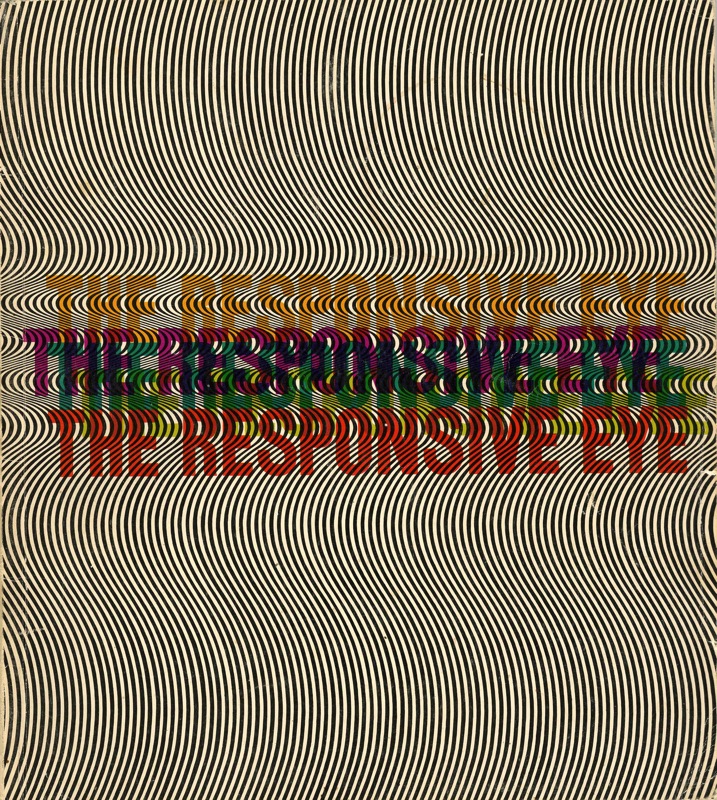William C. Seitz: The Responsive Eye (1965)
Filed under catalogue | Tags: · abstract art, art, op art, painting, perception

“In 1965, an exhibition called The Responsive Eye, created by William C. Seitz was held at the Museum of Modern Art in New York City. The works shown were wide ranging, encompassing the minimalism of Frank Stella and Ellsworth Kelly, the smooth plasticity of Alexander Liberman, the collaborative efforts of the Anonima group, alongside the well-known Victor Vasarely, Richard Anuszkiewicz, and Bridget Riley. The exhibition focused on the perceptual aspects of art, which result both from the illusion of movement and the interaction of color relationships. The exhibition was enormously popular with the general public, though less so with the critics. Critics dismissed op art as portraying nothing more than trompe l’oeil, or tricks that fool the eye. Regardless, op art’s popularity with the public increased, and op art images were used in a number of commercial contexts. Bridget Riley tried to sue an American company, without success, for using one of her paintings as the basis of a fabric design.” (Wikipedia)
Publisher Museum of Modern Art, New York; in collaboration with The City Art Museum of St. Louis, The Contemporary Art Council of the Seattle Art Museum, The Pasadena Art Museum, and The Baltimore Museum of Art, 1965
58 pages
Exh. review: Thomas B. Hess (ARTnews, 1965).
Brian de Palma’s “The Responsive Eye” (film, on UbuWeb)
Publisher (incl. press releases and installation views)
PDF (12 MB, no OCR)
PDF (scan from UbuWeb, contributed by Marcelo Gutman, 80 MB)
PDF (scan from MoMA, 12 MB, added on 2016-9-18)
Cretien van Campen: The Hidden Sense: Synesthesia in Art and Science (2007)
Filed under book | Tags: · art and science, brain, cognition, music, neuropsychology, perception, psychology, science, synaesthesia, visual music

What does it mean to hear music in colors, to taste voices, to see each letter of the alphabet as a different color? These uncommon sensory experiences are examples of synesthesia, when two or more senses cooperate in perception. Once dismissed as imagination or delusion, metaphor or drug-induced hallucination, the experience of synesthesia has now been documented by scans of synesthetes’ brains that show “crosstalk” between areas of the brain that do not normally communicate. In The Hidden Sense, Cretien van Campen explores synesthesia from both artistic and scientific perspectives, looking at accounts of individual experiences, examples of synesthesia in visual art, music, and literature, and recent neurological research.
Van Campen reports that some studies define synesthesia as a brain impairment, a short circuit between two different areas. But synesthetes cannot imagine perceiving in any other way; many claim that synesthesia helps them in daily life. Van Campen investigates just what the function of synesthesia might be and what it might tell us about our own sensory perceptions. He examines the experiences of individual synesthetes—from Patrick, who sees music as images and finds the most beautiful ones spring from the music of Prince, to the schoolgirl Sylvia, who is surprised to learn that not everyone sees the alphabet in colors as she does. And he finds suggestions of synesthesia in the work of Scriabin, Van Gogh, Kandinsky, Nabokov, Poe, and Baudelaire.
What is synesthesia? It is not, van Campen concludes, an audiovisual performance, a literary technique, an artistic trend, or a metaphor. It is, perhaps, our hidden sense—a way to think visually; a key to our own sensitivity.
Publisher MIT Press, 2008
Leonardo Books series
ISBN 0262220814, 9780262220811
185 pages
PDF (updated on 2013-3-19)
Comment (0)Roy Ascott (ed.): Art, Technologies, Consciousness: mind@large (2000)
Filed under book | Tags: · architecture, art, artificial life, computer music, consciousness, interactivity, metaphysics, music, perception, performance, quantum mechanics, robotics, semiotics, synaesthesia, technoetics, technology, telematics

Within a technological context, this volume addresses contemporary theories of consciousness, subjective experience, the creation of meaning and emotion, and relationships between cognition and location. Its focus is both on and beyond the digital culture, seeking to assimilate new ideas emanating from the physical sciences as well as embracing spiritual and artistic aspects of human experience.
Developing on the studies published in Roy Ascott’s successful Reframing Consciousness, the book documents the very latest work from those connected with the internationally acclaimed CAiiA-STAR centre and its conferences. Their artistic and theoretical research in new media and art includes aspects of:
• artificial life
• robotics
• technoetics
• performance
• computer music
• intelligent architecture
• telematic art
With profound insights for those in fields of Art, Media and Design – both academics and professionals — this book will also provide new ideas for software designers working on material to be used by the arts community.
Publisher Intellect Books, 2000
ISBN 1841500410, 9781841500416
204 pages
PDF (updated on 2012-7-24)
Comment (1)
